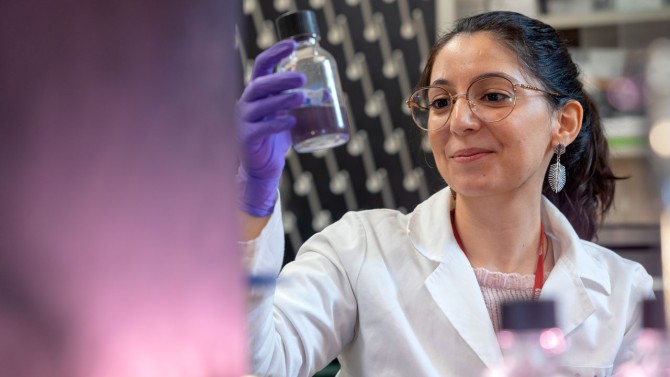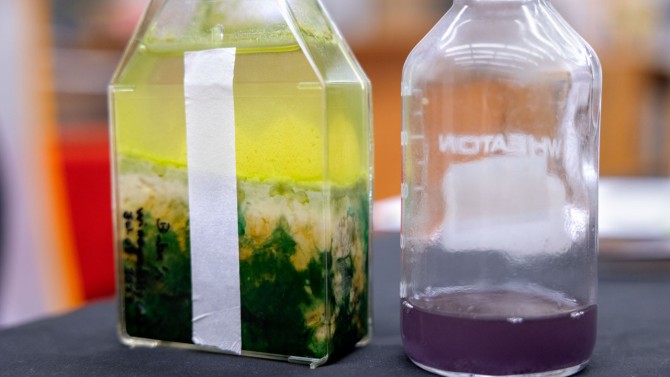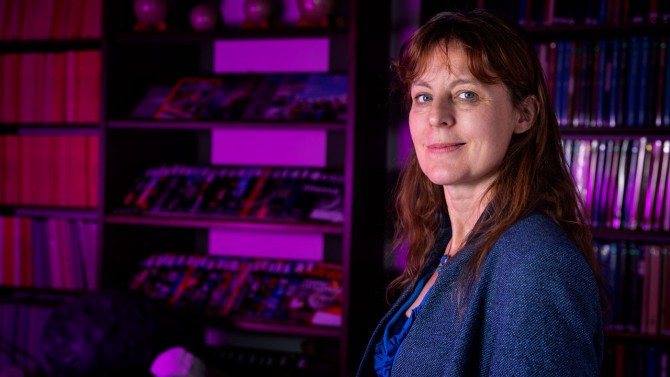On Earth, green signifies life, thanks to chlorophyll-driven photosynthesis. But on exoplanets, Cornell researchers have found that purple could be a key color to look for. Some bacteria on Earth already use infrared light for photosynthesis and contain purple pigments instead.
In search for alien life, purple may be the new green
By James Dean, Cornell Chronicle
From house plants and gardens to fields and forests, green is the color we most associate with surface life on Earth, where conditions favored the evolution of organisms that perform oxygen-producing photosynthesis using the green pigment chlorophyll a.
But an Earth-like planet orbiting another star might look very different, potentially covered by bacteria that receive little or no visible light or oxygen, as in some environments on Earth, and instead use invisible infrared radiation to power photosynthesis. Instead of green, many such bacteria on Earth contain purple pigments, and purple worlds on which they are dominant would produce a distinctive “light fingerprint” detectable by next-generation ground- and space-based telescopes, Cornell scientists report in new research.
“Purple bacteria can thrive under a wide range of conditions, making it one of the primary contenders for life that could dominate a variety of worlds,” said Lígia Fonseca Coelho, a postdoctoral associate at the Carl Sagan Institute (CSI) and first author of “Purple is the New Green: Biopigments and Spectra of Earth-like Purple Worlds,” published April 16 in Monthly Notices of the Royal Astronomical Society: Letters.
“We need to create a database for signs of life to make sure our telescopes don’t miss life if it happens not to look exactly like what we encounter around us every day,” added co-author Lisa Kaltenegger, CSI director and associate professor of astronomy in the College of Arts and Sciences.
Astronomers have confirmed more than 5,500 exoplanets to date, including more than 30 potentially Earth-like planets. Planned observatories such as the Extremely Large Telescope and Habitable Worlds Observatory will explore the chemical makeup of these worlds in their stars’ habitable zones – where conditions are conducive to the existence of liquid water on surface – and analyses of their composition.
Using life on Earth as a guide, CSI’s multidisciplinary team of scientists – also including William Philpot, professor emeritus in the School of Civil and Environmental Engineering in Cornell Engineering, and Stephen Zinder, professor emeritus of microbiology in the College of Agriculture and Life Sciences – are cataloging the colors and chemical signatures that a diverse range of organisms and minerals would present in an exoplanet’s reflected light.
Coelho collected and grew samples of more than 20 purple sulfur and purple non-sulfur bacteria that may be found in a variety of environments, from shallow waters, coasts and marshes to deep-sea hydrothermal vents. Zinder and Coelho scooped some samples from a pond on Cornell’s campus, while others were retrieved from waters off Cape Cod by Coelho during the 2023 Microbial Diversity summer course at the Marine Biological Laboratory at Woods Hole, and from lab cultures maintained by collaborators from the University of Minnesota’s Department of Plant and Microbial Biology, Associate Professor Trinity Hamilton and doctoral student Taylor Price.
What are collectively referred to as purple bacteria actually have a range of colors including yellow, orange, brown and red due to pigments related to those that make tomatoes red and carrots orange. They thrive on low-energy red or infrared light using simpler photosynthesis systems utilizing forms of chlorophyll that absorb infrared and don’t make oxygen. They are likely to have been prevalent on early Earth before the advent of plant-type photosynthesis, the researchers said, and could be particularly well-suited to planets that circle cooler red dwarf stars – the most common type in our galaxy.
“They already thrive here in certain niches,” Coelho said. “Just imagine if they were not competing with green plants, algae and bacteria: A red sun could give them the most favorable conditions for photosynthesis.”
After measuring the purple bacteria’s biopigments and light fingerprints, the researchers created models of Earth-like planets with varying conditions and cloud cover. Across a range of simulated environments, Coelho said, both wet and dry purple bacteria produced intensely colored biosignatures.
“If purple bacteria are thriving on the surface of a frozen Earth, an ocean world, a snowball Earth or a modern Earth orbiting a cooler star,” Coelho said, “we now have the tools to search for them.”
Detecting a “pale purple dot” in another solar system would trigger intensive observations of the planet to try to rule out other color sources, such as colorful minerals, which CSI also is cataloging. Kaltenegger, author of the forthcoming book, “Alien Earths: The New Science of Planet Hunting in the Cosmos,” said detecting life is so difficult with current technology that if even single-celled organisms are found in one place, it would suggest that life must be widespread in the cosmos. That would revolutionize our thinking about the age-old question: Are we alone in the universe?
“We are just opening our eyes to these fascinating worlds around us,” Kaltenegger said. “Purple bacteria can survive and thrive under such a variety of conditions that it is easy to imagine that on many different worlds, purple may just be the new green.”
The research was supported by a Fulbright Schuman grant, the Brinson Foundation and the National Science Foundation.
Media Contact
Get Cornell news delivered right to your inbox.
Subscribe



